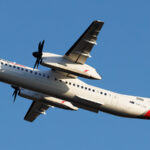In an increasingly sustainability-focused world, air cargo transportation faces significant challenges in reducing its carbon footprint. One of the most promising solutions is the use of Sustainable Aviation Fuel (SAF).
This is a new technology that offers substantial opportunities but also presents enormous challenges. Indeed, this innovation could pave the way for a more sustainable future in aviation, but it also involves risks and technological changes that pose a significant challenge.
What is SAF?
To be considered as sustainable aviation fuel, the produced compound must meet several criteria. The first, and perhaps one of the most stringent, is that it must reduce carbon emissions by 50 to 60 percent. Additionally, it must come from sources that do not harm the environment in their production process.
Various types of fuels exist. The most developed ones are derived from natural sources, such as lipids (vegetable oils and animal fats), in a process similar to biodiesel production and other compounds used as substitutes for automotive fuels.
Others are linked to the fermentation of plants, leading to the production of bioethanol and related products. Through complex biochemical processes, they can be converted into hydrocarbons suitable for use as SAF.
Advantages of Sustainable Aviation Fuel

One of the first and most evident advantages is the reduction of carbon emissions. SAF is produced from renewable sources, such as biomass and agricultural waste. Its use can reduce carbon emissions compared to conventional fossil fuels, which is essential for meeting emissions reduction goals set by governments and international organizations.
Moreover, SAF offers a significant advantage compared to other proposed technological changes. Its development makes it compatible with existing infrastructures and, especially, with current aircraft engines. It does not involve a technological change in the aircraft themselves, only in their fuel.
This is a significant advantage over other proposals, such as the use of hydrogen or electricity. While these other developments may be important and even revolutionary, they would require much more substantial changes.
Challenges for Sustainable Aviation Fuel
Despite the opportunities, the large-scale implementation of this type of fuel faces significant challenges. The first and most crucial challenge is production scale: its production is still limited, as it is often in testing phases or just beginning to be integrated into commercial aviation.
For instance, American Airlines, one of the pioneers in using this fuel worldwide, has signed agreements to purchase millions of liters of sustainable fuel. However, despite its importance, they have committed to using SAF for only 10% of their fuel by 2030. Although it may be a significant challenge, its impact will be relatively limited.
Another aspect, as mentioned before, is that biofuel production is not limited to aviation. Cars or ships are also potential customers for this production. Additionally, in many cases, biofuels are produced from agricultural products, which can cause severe inconveniences when dealing with food products.
Finally, there is the issue of price. Due to the technologies used and production scale, SAF costs more than conventional petroleum-based fuels. To enable widespread adoption, it should be competitive with the industry’s typical costs.
Innovation and Collaboration
To leverage the opportunities of SAF and overcome the challenges, innovation and collaboration among different stakeholders are essential. In this regard, researchers, airlines, oil companies, governments, and other sectors must work together.
In this sense, research, development, and production of sustainable raw materials for SAF are crucial to increase availability and reduce costs. For example, using used cooking oils could significantly reduce costs.
Governments https://www.energy.gov/eere/bioenergy/sustainable-aviation-fuels can play a significant role by not only legislating carbon footprints but also providing incentives such as subsidies and tax reductions to promote SAF production and adoption. International organizations also seek ways to promote its use https://www.iata.org/en/programs/environment/sustainable-aviation-fuels/.
Lastly, collaboration between airlines, aircraft manufacturers, and energy companies is essential to develop efficient and scalable supply chains that make the industry viable.
Sustainable aviation fuel emerges as an opportunity to reduce carbon emissions in air transportation in general and in air cargo in particular. Although it faces significant challenges, the technology is available and continues to be developed.
The use of SAF offers benefits for companies and, especially, for society as a whole. If a virtuous collaboration occurs between businesses, governments, consumers, and researchers, we may be facing a cleaner and more efficient solution for the transportation industry.










